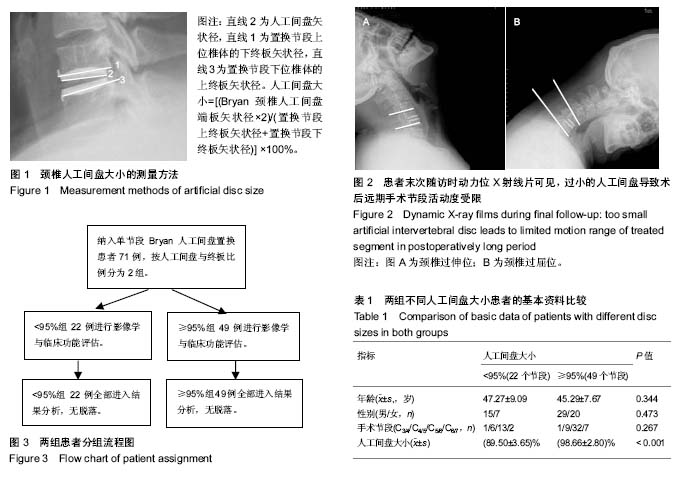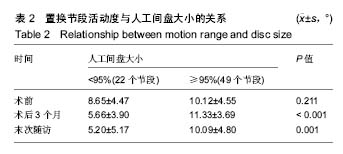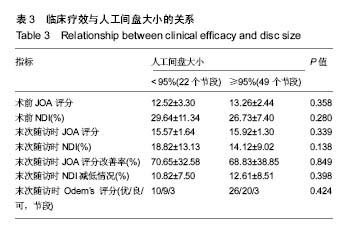| [1] Tian W, Han X, Liu B, et al. Clinical and radiographic results of cervical artificial disc arthroplasty: over three years follow-up cohort study. Chin Med J. 2010;123(21): 2969-2973.[2] Wu AM, Xu H, Mullinix KP, et al. Minimum 4-year outcomes of cervical total disc arthroplasty versus fusion: a meta-analysis based on prospective randomized controlled trials. Medicine. 2015;94(15):e665.[3] Shriver MF, Lubelski D, Sharma AM, et al. Adjacent segment degeneration and disease following cervical arthroplasty: a systematic review and meta-analysis. Spine J. 2016;16(2):168-181.[4] 韩骁,田伟,刘波,等. 不同影像学及症状学诊断颈椎退行性疾病患者行人工颈椎间盘置换术的中长期随访研究[J]. 中华骨与关节外科杂志, 2015, 8(1):15-20.[5] Quan GM, Vital JM, Hansen S, et al. Eight-year clinical and radiological follow-up of the Bryan cervical disc arthroplasty. Spine. 2011;36(8):639-646.[6] Thaler M, Hartmann S, Gstöttner M, et al. Footprint mismatch in total cervical disc arthroplasty. Eur Spine J. 2013;22(4):759-765.[7] Feng H, Fang XY, Huang DG, et al. A morphometric study of the middle and lower cervical vertebral endplates and their components. Medicine. 2017;96(10):e6296.[8] Ganbat D, Kim YH, Kim K, et al. Effect of mechanical loading on heterotopic ossification in cervical total disc replacement: a three-dimensional finite element analysis. Biomech Model Mechanobiol. 2015;15(5):1191-1199.[9] Lin CY, Kang HJ. Stress analysis of the interface between cervical vertebrae end plates and the Bryan, Prestige LP, and ProDisc-C cervical disc prostheses: an in vivo image-based finite element study. Spine. 2009;34(15):1554-1560.[10] 伍少玲,马超,伍时玲,等. 颈椎功能障碍指数量表的效度与信度研究[J]. 中国康复医学杂志, 2008, 23(7):625-628.[11] 田伟,吕艳伟,刘亚军,等. 北京市18岁以上居民颈椎病现况调查研究[J]. 中华骨科杂志,2012,32(8):707-713.[12] Burkhardt BW, Brielmaier M, Schwerdtfeger K, et al. Smith-Robinson procedure with an autologous iliac crest graft and caspar plating: report of 65 patients with an average follow-up of 22 years. World Neurosurg. 2016;90:244-250.[13] Burkhardt BW, Brielmaier M, Schwerdtfeger K, et al. Clinical outcome following anterior cervical discectomy and fusion with and without anterior cervical plating for the treatment of cervical disc herniation—a 25-year follow-up study. Neurosurg Rev. 2017. doi: 10.1007/s10143-017-0872-6. [Epub ahead of print][14] Kim SJ, Sang DK. Anterior cervical discectomy and fusion using a double cylindrical cage versus an anterior cervical plating system with iliac crest autografts for the treatment of cervical degenerative disc disease. J Korean Neurosurg Soc. 2014;55(1):12-17.[15] Shao MH, Fan Z, Yin J, et al. Titanium cages versus autogenous iliac crest bone grafts in anterior cervical discectomy and fusion treatment of patients with cervical degenerative diseases: a systematic review and meta-analysis. Curr Med Res Opin. 2017;33(5):803-811.[16] Sayyahmelli S, Alipanahi R. Anterior cervical discectomy and fusion with polyether ether ketone cage. Global Spine J. 2014;4(S1): 1023-1025.[17] Phillips FM, Geisler FH, Gilder KM, et al. Long-term outcomes of the US FDA IDE prospective, randomized controlled clinical trial comparing PCM cervical disc arthroplasty with anterior cervical discectomy and fusion. Spine. 2015;40(10):674-683.[18] van Eck CF, Regan C, Donaldson WF, et al. The revision rate and occurrence of adjacent segment disease after anterior cervical discectomy and fusion: a study of 672 consecutive patients. Spine. 2015;15(10):S165-S165.[19] Kong L, Cao J, Wang L, et al. Prevalence of adjacent segment disease following cervical spine surgery: A PRISMA-compliant systematic review and meta-analysis. Medicine. 2016;95(27):e4171.[20] Li J, Tong T, Niu R, et al. A study on the clinical outcomes of patients with revision surgery for adjacent segment disease after 10-year’s anterior cervical spine surgery. J Orthop Surg Res. 2016;11(1):5.[21] Zhang Y, Liang C, Tao Y, et al. Cervical total disc replacement is superior to anterior cervical decompression and fusion: a meta-analysis of prospective randomized controlled trials. Plos One. 2015;10(3):e0117826.[22] Demetriades AK, Ringel F, Meyer B. Cervical disc arthroplasty: a critical review and appraisal of the latest available evidence[M]// Advances and technical standards in neurosurgery. Springer International Publishing, 2014:107.[23] Qiang Y, Feng L, Yang X, et al. A meta-analysis comparing total disc arthroplasty with anterior cervical discectomy and fusion for the treatment of cervical degenerative diseases. Arch Orthop Trauma Surg. 2016;136(3):297-304.[24] Fay LY, Huang WC, Wu JC, et al. Arthroplasty for cervical spondylotic myelopathy: similar results to patients with only radiculopathy at 3 years' follow-up. J Neurosurg Spine. 2014;21(3):400-410.[25] Lee JH, Park WM, Kim YH, et al. A biomechanical analysis of an artificial disc with a shock-absorbing core property by using whole-cervical spine finite element analysis. Spine. 2016;41(15):E893.[26] Mcdonald CP, Chang V, Mcdonald M, et al. Three-dimensional motion analysis of the cervical spine for comparison of anterior cervical decompression and fusion versus artificial disc replacement in 17 patients: clinical article. J Neurosurg Spine. 2014; 20(3):245-255.[27] Mo Z, Zhao Y, Du C, et al. Does location of rotation center in artificial disc affect cervical biomechanics? Spine. 2015;40(8):E469.[28] Mummaneni PV, Burkus JK, Haid RW, et al. Clinical and radiographic analysis of cervical disc arthroplasty compared with allograft fusion: a randomized controlled clinical trial. J Neurosurg Spine. 2007;6(3):198.[29] Galbusera F, Bellini CM, Brayda-Bruno M, et al. Biomechanical studies on cervical total disc arthroplasty: A literature review. Clin Biomech. 2008;23(9):1095-1104.[30] Yanbin Z, Yu S. In vitro biomechanics of cervical arthroplasty with Bryan disc prosthesis or ProDisc-C prosthesis: a cadaveric study. Global Spine J. 2014.[31] Lazaro BC, Yucesoy K, Yuksel KZ, et al. Effect of arthroplasty design on cervical spine kinematics: analysis of the Bryan Disc, ProDisc-C, and Synergy disc. Neurosurg Focus. 2010;28(6):E6.[32] Ryu W H, Kowalczyk I, Duggal N. Long-term kinematic analysis of cervical spine after single-level implantation of Bryan cervical disc prosthesis. Spine J. 2013;13(6):628-634.[33] Zhao Y, Zhang Y, Sun Y, et al. Application of cervical arthroplasty with bryan cervical disc: 10-year follow-up results in China. Spine, 2016; 41(2):111.[34] Liberati C, Assietti R. Clinical and radiological results of Bryan cervical disc arthroplasty after follow-up of ten years. Spine J. 2015;15(10): S124-S124.[35] Dejaegher J, Walraevens J, Loon J V, et al. 10-year follow-up after implantation of the Bryan cervical disc prosthesis. Eur Spine J. 2017;26(4):1191-1198.[36] 戎鑫,刘浩,龚全,等. 颈椎下终板矢状面形态分型[J]. 中国矫形外科杂志, 2015,23(5):406-411.[37] Beer ND, Scheffer C. Reducing subsidence risk by using rapid manufactured patient-specific intervertebral disc implants. Spine J. 2012;12(11):1060-1066.[38] Tan SH,Teo EC,Chua HC,et al.Quantitative three-dimensional anatomy of cervical, thoracic and lumbar vertebrae of Chinese Singaporeans. Eur Spine J.2004;13(2):137-146.[39] Kim MK,Kwak DS,Park CK,et al.Quantitative anatomy of the endplate of the middle and lower cervical vertebrae in Koreans.Spine (Phila Pa 1976). 2007;32(14):E376-381. [40] Jin YJ, Park SB, Kim MJ, et al. An analysis of heterotopic ossification in cervical disc arthroplasty: a novel morphologic classification of an ossified mass. Spine J. 2013;13(4):408.[41] Lei T, Liu Y, Wang H, et al. Clinical and radiological analysis of Bryan cervical disc arthroplasty: eight-year follow-up results compared with anterior cervical discectomy and fusion. Int Orthop. 2016;40(6): 1197-1203.[42] Dejaegher J, Walraevens J, Van LJ, et al. 10-year follow-up after implantation of the Bryan Cervical Disc Prosthesis. Eur Spine J. 2017;26(4):1191-1198.[43] 张传健,丁坦,王哲,等. 人工颈椎间盘置换术临床应用探讨与存在问题[J].中国矫形外科杂志,2017,25(5):442-447.[44] Yi S, Kim KN, Yang MS, et al. Difference in occurrence of heterotopic ossification according to prosthesis type in the cervical artificial disc replacement. Spine. 2010;35(16):1556-1561. |
.jpg)



.jpg)